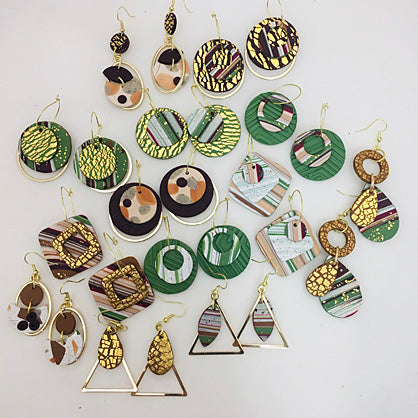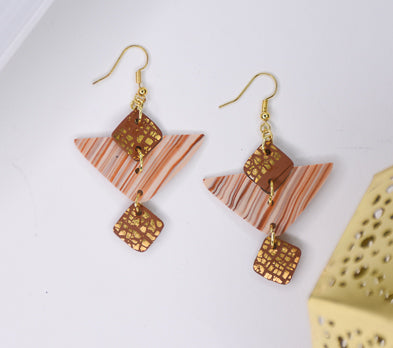Sculpey Premo™ Unique Multiples Gold Leaf Earrings
Sculpey Premo™ Unique Multiples Gold Leaf Earrings
Designed by Amy Koranek
Read More
This the fourth part of a six part series of tutorials based on mass producing earrings that are all unique in design. This series features Terrazzo, Floral, Pebble, Gold Leaf, Texture, and Scrap all in the same color-way for a myriad of combinations. A great way to create lots of mix and match pieces that can be combined into unique styles. If you are just starting out to sell jewelry, this instruction teaches mass production techniques while building your business. The entire line of earrings that I have created with these pieces - over 40 pairs of earrings - came from just 6 – 2 ounce bars of clay
The Tools and Supply Lists here may be overkill for just this one section of the tutorial. I’m including everything in each section for the total project so that you can keep the overall outcome in focus.
Read Less
The Tools and Supply Lists here may be overkill for just this one section of the tutorial. I’m including everything in each section for the total project so that you can keep the overall outcome in focus.
ADDITIONAL SUPPLIES
- Interfolded clear plastic deli and bakery wrap - or - plastic kitchen wrap
- Stiff cardboard or extra baking trays for scrap organization
- Gold composite leaf
- Dremel or Dremel Stylo
- Egg cartons for sorting pairs
- 6mm Gold tone jump rings
- 8mm Gold tone jump rings
- Gold tone ear wires
- Gold tone ear posts and backs
- Gold tone connectors in various shapes
- Silicone glue or instant drying glue
- Flat nose pliers
- Teardrop Clay Cutters by Craft Smart®
- Square & Circle Premium Clay Cutters by Craft Smart®
- Edgy Texture Sheet Set by Craft Smart®

Project Instructions
- Getting Started:
Start with clean hands, unwrap and knead clay until soft and smooth, or condition by running clay though a Pasta Machine. We recommend using a designated machine for clay purposes only. When working with multiple colors, clean hands with soap and water or baby wipes (we have found that baby wipes work best) before switching colors. Shape clay, pressing pieces firmly together. Wash hands after use.
- Baking:
For the background colors, we will use the darkest colors from our color way so that the leaf really shines on the surface in contrast. Sheet the remaining portions of each Raw Sienna, Spanish Olive, and Alizarin Crimson through the pasta machine to the second thickest setting. Cut out a nice square shape and set the scraps aside for later use.
Keeping scraps organized along the way will make them easier to use later. Store solid color scraps together on pieces of plastic wrap placed on top of something stiff. The plastic wrap will keep the clay from leaching it’s valuable plasticizer away. The stiff object, like an extra baking tray or a piece of cardboard, will make it easy to pick up and move the scrap clay around to bring it into or away from the project at hand.
Keeping scraps organized along the way will make them easier to use later. Store solid color scraps together on pieces of plastic wrap placed on top of something stiff. The plastic wrap will keep the clay from leaching it’s valuable plasticizer away. The stiff object, like an extra baking tray or a piece of cardboard, will make it easy to pick up and move the scrap clay around to bring it into or away from the project at hand.

Cut Raw Sienna in half. Set aside one half for later use. Smooth gold composite leaf on the right half of the Raw Sienna sheet.

Fold the sheet with the gold leaf in half with the gold leaf on the outsides and press it through the pasta machine again on the second thickest setting. This will crackle and spread the gold leaf across the surface. It will also produce a sheet of clay with crackled gold leaf on both sides of the sheet.

Repeat Steps 3 and 4 in Spanish Olive and also in Alizarin Crimson (Alizarin Crimson not shown).

Cut out a few large circles so that you have large pieces for focal points from the Gold Leaf clay sheets.
Move the cut shapes from the work area onto pieces of plastic wrap placed on top of something stiff. The plastic wrap will keep the clay from leaching it’s valuable plasticizer away. The stiff object, like an extra baking tray or a piece of cardboard, will make it easy to pick up and move the shapes around as needed.
Move the cut shapes from the work area onto pieces of plastic wrap placed on top of something stiff. The plastic wrap will keep the clay from leaching it’s valuable plasticizer away. The stiff object, like an extra baking tray or a piece of cardboard, will make it easy to pick up and move the shapes around as needed.

Also cut smaller shapes from the Gold Leaf sheets so that you have lots of accent pieces for the earring designs.
Move the cut shapes from the work area onto pieces of plastic wrap placed on top of something stiff. The plastic wrap will keep the clay from leaching it’s valuable plasticizer away. The stiff object, like an extra baking tray or a piece of cardboard, will make it easy to pick up and move the shapes around as needed.
Set the scraps aside. These will also be used in the Scrap Tutorial.
Keeping scraps organized along the way will make them easier to use later. Store patterned scraps together on pieces of plastic wrap placed on top of something stiff. The plastic wrap will keep the clay from leaching its valuable plasticizer away. The stiff object, like an extra baking tray or a piece of cardboard, will make it easy to pick up and move the scrap clay around to bring it into or away from the project at hand.
Move the cut shapes from the work area onto pieces of plastic wrap placed on top of something stiff. The plastic wrap will keep the clay from leaching it’s valuable plasticizer away. The stiff object, like an extra baking tray or a piece of cardboard, will make it easy to pick up and move the shapes around as needed.
Set the scraps aside. These will also be used in the Scrap Tutorial.
Keeping scraps organized along the way will make them easier to use later. Store patterned scraps together on pieces of plastic wrap placed on top of something stiff. The plastic wrap will keep the clay from leaching its valuable plasticizer away. The stiff object, like an extra baking tray or a piece of cardboard, will make it easy to pick up and move the scrap clay around to bring it into or away from the project at hand.

Audition how you will use the Gold Leaf pieces along with the other patterned pieces from this six part series - Pebble, Floral, Terrazzo, Gold Leaf, Texture, and Scrap. Once you like the look of the designs, you can mark where holes will need to be drilled with the Needle Tool. Be sure to mark holes for ear wires if you want the earrings to dangle. Leave top pieces unmarked for holes if you want them to be post style earrings.
Separate the pieces from each other and then bake following the baking instructions in Step 1 above. Allow them to cool completely before handling.
After baking, the holes can be drilled with a Dremel drill or Dremel Stylo for speedy production drilling. When using an electric drill, use a bit that is larger than the jump rings. This way the pieces will be allowed to move freely when assembled.
Separate the pieces from each other and then bake following the baking instructions in Step 1 above. Allow them to cool completely before handling.
After baking, the holes can be drilled with a Dremel drill or Dremel Stylo for speedy production drilling. When using an electric drill, use a bit that is larger than the jump rings. This way the pieces will be allowed to move freely when assembled.

After drilling, drop pairs of earrings into empty egg cartons to keep all the parts of a pair of earrings together and sorted.

Assemble earrings with jump rings using flat nose pliers to open and close the jump rings and ear wires. Glue ear posts to the backs of pairs which are chosen for post designs.

Here is just one pair highlighting the Gold Leaf pieces that we made in this tutorial. The elements are all connected together with jump rings using flat nose pliers. The ear wires are attached through a hole at the top using additional jump rings so that the earrings are oriented to be worn front facing.

- Choosing a selection results in a full page refresh.
- Opens in a new window.

